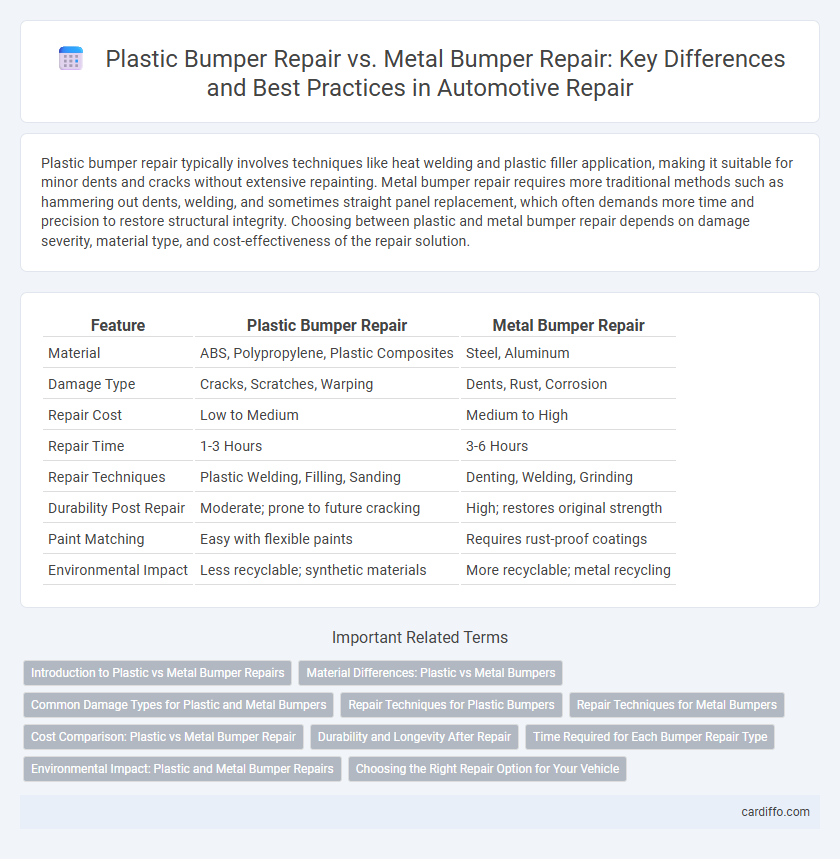Plastic bumper repair typically involves techniques like heat welding and plastic filler application, making it suitable for minor dents and cracks without extensive repainting. Metal bumper repair requires more traditional methods such as hammering out dents, welding, and sometimes straight panel replacement, which often demands more time and precision to restore structural integrity. Choosing between plastic and metal bumper repair depends on damage severity, material type, and cost-effectiveness of the repair solution.
Table of Comparison
| Feature | Plastic Bumper Repair | Metal Bumper Repair |
|---|---|---|
| Material | ABS, Polypropylene, Plastic Composites | Steel, Aluminum |
| Damage Type | Cracks, Scratches, Warping | Dents, Rust, Corrosion |
| Repair Cost | Low to Medium | Medium to High |
| Repair Time | 1-3 Hours | 3-6 Hours |
| Repair Techniques | Plastic Welding, Filling, Sanding | Denting, Welding, Grinding |
| Durability Post Repair | Moderate; prone to future cracking | High; restores original strength |
| Paint Matching | Easy with flexible paints | Requires rust-proof coatings |
| Environmental Impact | Less recyclable; synthetic materials | More recyclable; metal recycling |
Introduction to Plastic vs Metal Bumper Repairs
Plastic bumper repairs require specialized techniques such as plastic welding and the use of flexible fillers to restore their shape and durability, differing significantly from traditional metal repairs. Metal bumper repairs often involve hammering, welding, and sanding to fix dents and cracks, relying on the material's malleability and strength. Understanding the distinct methods and materials involved is crucial for effective and long-lasting bumper restoration.
Material Differences: Plastic vs Metal Bumpers
Plastic bumpers, made from polypropylene or thermoplastic olefins, offer flexibility and resistance to minor dents and scratches, making repairs generally faster and more cost-effective. Metal bumpers, often composed of steel or aluminum, provide superior strength and impact resistance but are prone to rust and require more labor-intensive processes like welding and repainting during repairs. Repair techniques differ significantly due to these material properties, with plastic requiring specialized adhesives and heat treatments, while metal involves dent removal, straightening, and corrosion prevention.
Common Damage Types for Plastic and Metal Bumpers
Plastic bumpers commonly suffer from scratches, cracks, and dents caused by low-impact collisions due to their flexible nature. Metal bumpers typically experience dents, rust, and paint chipping from higher-impact collisions and exposure to harsh environmental conditions. Repair techniques vary, with plastic requiring heat and adhesive treatments, while metal requires dent removal and rust prevention methods.
Repair Techniques for Plastic Bumpers
Plastic bumper repair techniques primarily involve heat welding, adhesive bonding, and plastic filler application, which restore flexibility and original shape. Heat welding uses specialized tools that melt and fuse plastic pieces, ensuring durable and seamless repairs. Adhesive bonding and fillers reinforce structural integrity while allowing quick curing, making plastic bumper repairs cost-effective and efficient compared to metal alternatives.
Repair Techniques for Metal Bumpers
Metal bumper repair techniques typically involve dent removal, welding, and refinishing to restore structural integrity and appearance. Technicians often use specialized tools such as stud welders and frame straighteners to precisely reshape the metal. Unlike plastic, metal bumpers may require corrosion protection treatments and repainting after repairs to prevent rust and ensure durability.
Cost Comparison: Plastic vs Metal Bumper Repair
Plastic bumper repair typically costs less than metal bumper repair due to lower labor intensity and easier material handling. Metal bumper repairs often require welding and repainting, increasing both time and expenses significantly. On average, plastic repairs range from $150 to $450, while metal repairs can exceed $600 depending on damage severity.
Durability and Longevity After Repair
Plastic bumper repair typically offers enhanced durability due to its flexibility and resistance to rust, allowing it to absorb minor impacts without cracking. Metal bumper repairs, while strong, can be prone to corrosion and may require more frequent touch-ups to maintain structural integrity. Longevity after plastic bumper repair generally surpasses metal, especially when specialized adhesives and fillers are used to restore original strength and resilience.
Time Required for Each Bumper Repair Type
Plastic bumper repair typically requires less time, often completed within a few hours due to the material's flexibility and ease of sanding, filling, and repainting. Metal bumper repair can take longer, frequently extending to a day or more, as it involves processes like dent removal, welding, rust treatment, and repainting. The complexity and labor intensity associated with metal repair usually contribute to extended repair times compared to plastic bumpers.
Environmental Impact: Plastic and Metal Bumper Repairs
Plastic bumper repairs generally have a lower environmental impact due to the use of less energy-intensive processes and the ability to restore parts rather than replace them entirely. Metal bumper repairs often involve welding, grinding, and painting, which consume more resources and generate hazardous waste. Choosing plastic repair techniques can reduce carbon emissions and minimize landfill waste compared to metal repair methods.
Choosing the Right Repair Option for Your Vehicle
Plastic bumper repair involves techniques like heat welding and plastic filler application, making it ideal for minor dents and scratches due to its flexibility and cost-effectiveness. Metal bumper repair often requires dent removal, welding, and repainting, providing stronger durability but higher costs and longer labor time. Assessing damage type, repair budget, and longevity needs helps determine whether plastic or metal bumper repair is the optimal choice for your vehicle.
plastic bumper repair vs metal bumper repair Infographic

 cardiffo.com
cardiffo.com